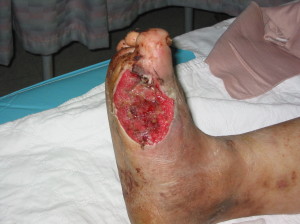Amniotic graft diabetic foot ulcers
The prevalence of diabetes in the United states is high, it is currently estimated that 14 percent of the united states suffers from diabetes . 4 percent of Diabetics will get a foot ulcer during the year and 25 percent of diabetics will gat a foot ulcer at least once in their life time.
Foot ulcers can be very dangerous and can lead to infections and possible amputations if not treated quickly and properly. Diabetics are advised to get annual foot screenings to assess their risks for ulcers. Risks for ulcers include bony prominence’s such as bunions and hammertoes that rub against improper shoes that can lead to ulcers. Also poor circulation and poor blood flow can lead to ulcers. And lastly neuropathy can lead to ulcers which can lead to amputations. Neuropathy is the loss of sensation in ones feet so if you have a pebble in your shoe you will not feel it and then it can lead to an ulcer which can lead to infection….
There are many treatments available for treating ulcers, a new treatment that I am performing at the Advanced Foot and ankle Center of San Diego with great success is human amniotic membrane allograft application. Wow that is allot of fancy words, let me explain. Human amniotic membrane allograft (HAMA for short) is donated from human placenta once a child is born.
Amniotic tissue has been used in therapy for treatment in surgeries of the eye and burns . The way it works is by reducing inflammation and enhancing soft tissue healing. There are many growth factors in amniotic tissue such as FGF, EGF, TGF that help stimulate epithilial cell growth and migration and can grow skin in ulcers and wounds. There is also present PDGF A and B which help the growth of collagen , fibroblasts and smooth muscle cells.
The placental membrane contains 2 layers , the chorion which is touching the maternal side of the placenta and the amnion which is touching the amniotic fluid and fetus. Both layers are non-immunogenic. A combination of the chorion with the amnion contains many growth factors to help ne skin cells grow and heal wounds. This is supplied as dehydrated human amnion/chorion membrane allograft and it can treat diabetic foot ulcers.
We have been able to cure hundreds of foot ulcers with this new treatment option available .
Below are some pictures of before and after healed diabetic foot ulcers that were treated with human amniotic membrane allograft.
- Diabetic foot ulcer before
- Diabetic foot ulcer before
- Diabetic foot ulcer after
- Diabetic foot ulcer





